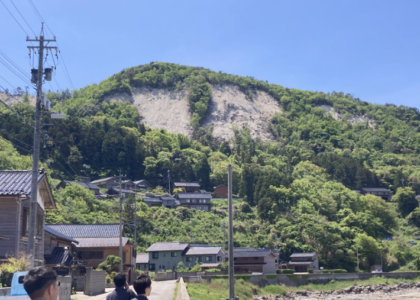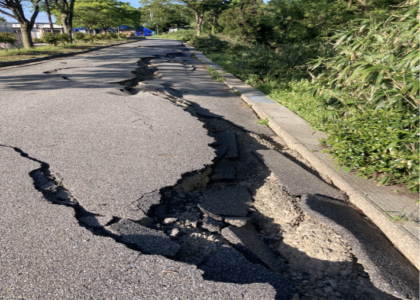News
On Saturday, May 11, we visited Wajima and Suzu cities on the Noto Peninsula by arrangement with the Noto Peninsula Earthquake Recovery and Reconstruction Promotion Department of Ishikawa Prefecture. We would like to express our sincere gratitude for accepting the invitation to visit these cities amidst the deep damage that remains and the top priority of recovery and reconstruction efforts.
Local conditions
Collapsed buildings are still intact and awaiting disaster certification. Numerous large landslides and landslides have occurred, burying some buildings. Some villages are isolated due to roads and tunnels cut off by landslides. There are still many dangerous areas, such as major roads currently in use that have collapsed on one side. In some areas, water pipes have been broken and the water supply has been cut off.

↑Maura area, Suzu City Numerous landslides have occurred. There is concern about secondary disasters during the rainy season.

↑Maura area, Suzu City This area was originally an inlet, but all of it has been turned into a sandy beach due to the uplift of the seafloor.

↑Roads in Wajima City There were many roads that have not yet been repaired. There continues to be a shortage of labor at construction sites.
Visits to modern settlements
We were introduced to Gendai Shuraku by the Noto Peninsula Earthquake Restoration and Recovery Promotion Department of Ishikawa Prefecture and paid a visit. Gendai Shuraku is a private team working on various projects based on the concept of "Technology x Marginalized Village = Gendai Shuraku" in the Manoura district of Suzu City, Ishikawa Prefecture. The team aims to create a natural symbiosis-type living area with autonomous decentralized infrastructure by introducing new technologies from outside the community, with the goal of creating an experimental site for "a prosperous life 100 years from now. The representative of the team, Mr. Hayashi, has purchased land and houses in the Manoura area and will start activities in 2021.
Website:https://villagedx.com/
About 20 households and 40 people live in the village, but there are still quite a few people who have returned to their homes at present. Mr. Hayashi has returned to the Manaura district to continue his activities in the modern village amidst the water cutoff. In the Manaura district, where the infrastructure has been destroyed, what is needed now is "water" and "oil (gasoline and kerosene). Water has not yet been restored due to a broken water pipe. Water is still not restored due to a broken water pipe, and people are driving to the area from across the mountain to bring water every day. In addition, a car is indispensable for daily life in the Mayaura district, including the transportation of drinking water. From here, gasoline is essential. Kerosene is also essential in the cold winter months. However, there is a possibility that oil (gasoline and kerosene) could be replaced by electricity by introducing electric vehicles and improving the insulation and electrification of houses.
About the future
In July, we will visit Hyundai village with the venture company to conduct a field survey for the demonstration.
(Written by Tomoko Tachibana, LIVERNESS Resilience Project)
